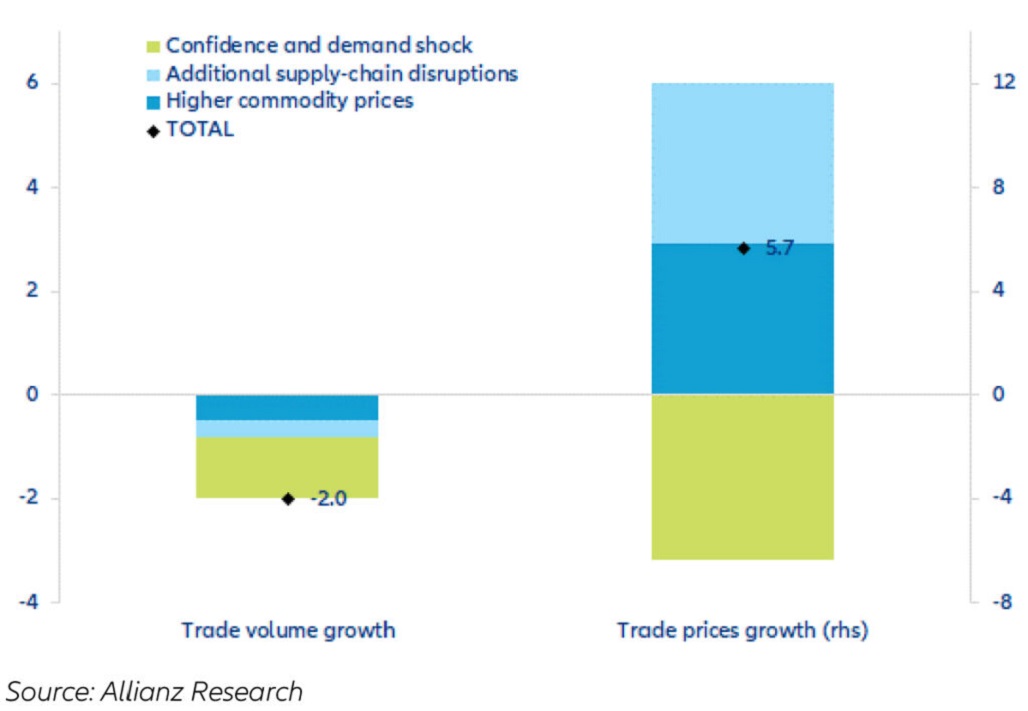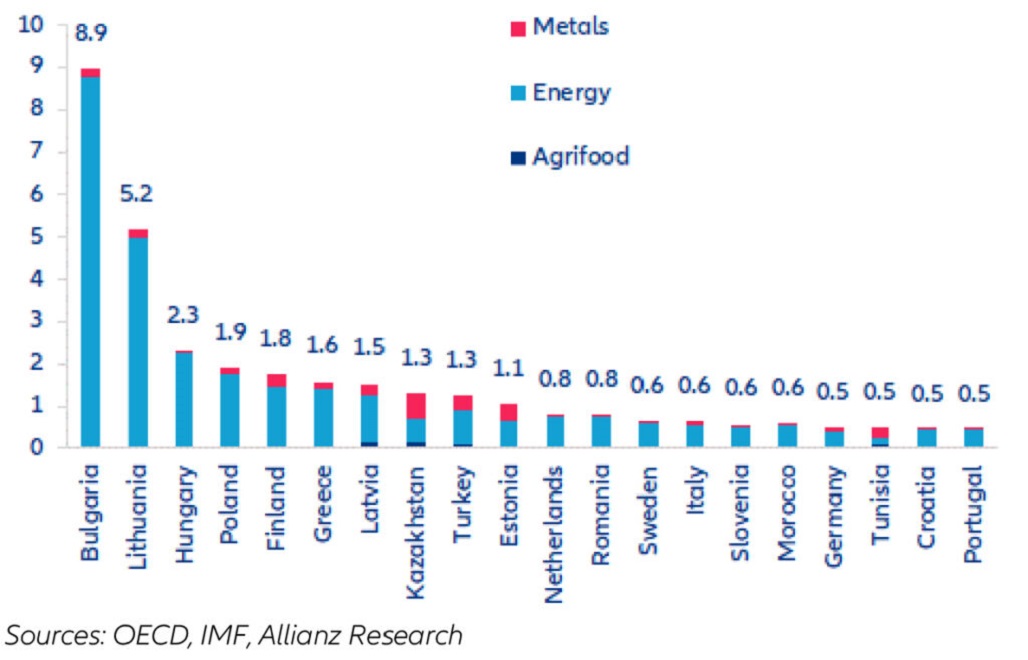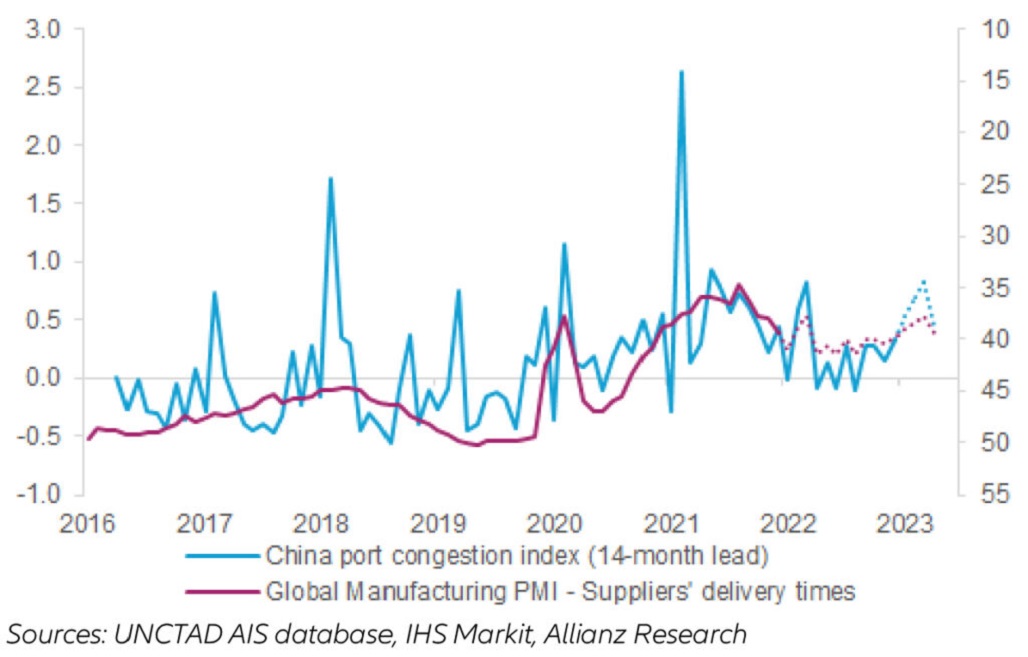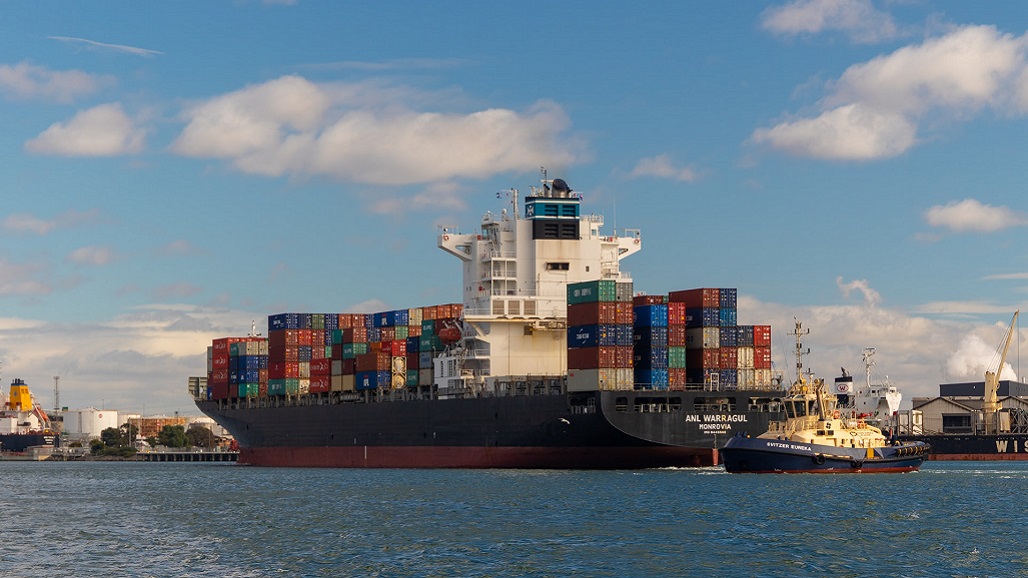Global trade will take a hit, particularly in Europe, as the conflict in Ukraine continues.
Photo: Unsplash
 The invasion of Ukraine and renewed COVID-19 outbreaks in China will hit global trade with a double whammy in 2022: lower volumes and higher prices. We now expect trade to grow by 4.0% in volume terms in 2022 (2 percentage points lower than expected before the crisis), while trade in value terms surges by 10.9% (vs. 7.2% previously expected).
The invasion of Ukraine and renewed COVID-19 outbreaks in China will hit global trade with a double whammy in 2022: lower volumes and higher prices. We now expect trade to grow by 4.0% in volume terms in 2022 (2 percentage points lower than expected before the crisis), while trade in value terms surges by 10.9% (vs. 7.2% previously expected).
After the contraction in Q3 2021, the risk of a double-dip in global trade volume in H1 2022 has increased further – not only due to supply-chain bottlenecks, but also because of lower demand. The economic consequences of Russia’s invasion of Ukraine will slow GDP growth around the world, especially for economies in Europe. The resulting confidence and demand shock explains more than half of the downward revision in our forecast for trade growth in volume in 2022 (see Exhibit 1). Conversely, trade prices growth has been revised upwards by 5.7 percentage points, with commodity prices and additional supply chain disruptions contributing roughly equally.

Exhibit 1: Breakdown of 2022 trade growth forecast revisions (percentage points)
The Demand Shock
The confidence and demand shock will result in a loss of $480 billion in exports to Russia and Eurozone countries in 2022 (roughly evenly split between the two destinations), with companies in Eastern Europe the most exposed. While Russia as an end-demand market is not systemic at the global level (representing just 1.2% of global imports on average in 2015-2019), the multi-year recession it is likely to face could lead to losses in the region.
The most exposed countries are Moldova, Slovakia, Serbia, Slovenia and Czech Republic, where exports exceed 1.5% of GDP. Among the biggest Eurozone exporters, Germany and Italy are among the top 20 most exposed, with potential losses of up to 0.6% ($21 billion) and 0.5% of GDP ($90 billion) respectively, in the worst-case scenario where relationships with Russia are completely frozen.
Looking at Russia as a supplier in global and regional value-chains, Eastern Europe remains the most at risk, while a complete cut-off of relations would mean the Eurozone’s largest four economies losing up to 0.4% of their GDPs and 1.1% of their exports.
Focus on Commodities
Looking at the world’s exposure to goods produced in Russia, the sectors of focus are energy (e.g., oil, gas), metals (e.g., aluminum, palladium, nickel) and agrifood (e.g., wheat, corn) as Russia respectively represents around 9%, 3% and 2% of each sector’s global exports. By looking precisely at the amount of energy, metals and agrifood inputs produced in Russia that end up in other countries’ outputs (through direct and indirect trade linkages), we find that Bulgaria (close to 9% of GDP), Lithuania (more than 5% of GDP) and Hungary (more than 2% of GDP) are the most exposed (see Exhibit 2).
Some Western and Northern European countries are also among the top 20 most exposed, including the Netherlands (0.8% of GDP), Sweden (0.6%), Italy (0.6%) and Germany (0.5%). This compares with 0.3% of Chinese GDP depending on Russian inputs, and 0.1% for the US. Looking at how much Russian value-added is used in other countries’ exports yields similar results, with Eastern European economies the most exposed, while up to 1.1% of exports from the largest four economies of the Eurozone could be at risk (compared with 0.7% for China and 0.2% for the US).

Exhibit 2: Russian energy, metals and agrifood inputs used in respective countries’ output (% of GDP), top 20 exposed in relative terms
Supply Chain Bottlenecks
Europe is thus by far the most at risk of supply-chain disruptions caused by the Russian invasion of Ukraine and ensuing sanctions. Beyond food and energy commodities, which can be easily substituted with other suppliers, metals are actually more sensitive products. Indeed, they are often part of an industrial process that has been designed to take into account the particularities of a certain supplier. As such, changing suppliers, even when possible, is not an easy task as it might require industrial adjustments. Based on the critical materials analysis from the European Commission, we observe that Russia represents over 10% of imports for about 20 metals, with key applications in transport equipment, high-end electronics (batteries, semiconductors, smartphones), construction and automotive.
To account for second-round supply-chain effects of ongoing events, value-added that needs to transit via Russia before reaching its final destination also needs to be taken into consideration, on top of that directly produced in Russia. We find that the latter has a much larger impact than the former, which is even negligible outside Europe. This confirms Russia’s limited role in global and regional supply chain logistics. Indeed, even if high-frequency data show that the number of tankers moving in the Black Sea and Baltic Sea, and the number of container vessels anchored in Russian ports, have declined since the start of the conflict, it is important to keep in mind that Russia represents just around 2-3% of the global tanker fleet and containerized trade.
New COVID-19 outbreaks in China are the larger issue for global supply chains as the sustained zero-COVID policy is likely to keep delivery times elevated throughout 2022. Local lockdowns and more restrictions in response to rising infections in cities such as Shenzhen and Shanghai are likely to impact production and logistics in China. Data show that congestion waiting times and anchorage outside the Yantian port and the outer Pearl River Delta have risen over the past few weeks. For now, they remain below the levels seen during summer 2021, when outbreaks led to temporary port closures.
However, this new bottleneck comes at a time when the global maritime shipping industry is still fragile. A repeat of the temporary port closures in China could have ripple effects on global logistics: The historical relationship between our proprietary China port congestion index and the global manufacturing PMI suppliers’ delivery times index (see Exhibit 3) suggests that delivery times are likely to remain above the pre-pandemic average for most of 2022, and even lengthen slightly at the start of 2023 – though remaining below 2021 peaks.

Exhibit 3: China port congestion index and global manufacturing sector delivery times
 Ana Boata
Ana Boata
Global Head of Economic Research at Allianz Trade
Ana Boata is the global head of Economic Research at Allianz Trade. Ana started her career in the banking sector before joining Euler Hermes in November 2012 as Eurozone economist. In 2018 she received the Best Forecaster Award for the Eurozone by Consensus Forecast. In 2019, she became head of Macroeconomic Research of Euler Hermes Group and led its thematic research on SMEs. Ana also teaches macroeconomics at the University of Paris Dauphine and Sciences Po Paris.
 Françoise Huang
Françoise Huang
Senior Economist for Asia-Pacific at Allianz Trade
Françoise joined Allianz Trade in 2019 as a senior economist for Asia-Pacific. Prior to this, Françoise worked as an Economist for over five years at the equity broker Exane BNP Paribas in London. There, she was in charge of the macroeconomic analysis of the Chinese economy and Emerging Markets. She also worked on global and European topical themes. Her other work experiences include the ACPR, the French supervisor for the banking and insurance sectors.
 Ano Kuhanathan
Ano Kuhanathan
Sector Advisor and Data Scientist at Allianz Trade
Ano Kuhanathan has held various positions in the financial industry in trading, research and consulting. He was the Eurozone economist at Axa Investment Managers from 2016 to 2018. Before joining Allianz Trade in 2020, he was the head of economic advisory and advanced analytics at EY Advisory. Ano regularly teaches economics, sustainable finance and applied data science at Neoma Business School.
A version of this article originally appeared in Unravel.
The original report can be read at the Brink’s website HERE.


Leave a Reply